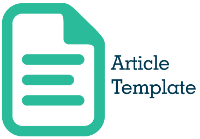KOMUNIKASI PEMBELAJARAN BERBASIS DARING UNTUK ANAK BERKEBUTUHAN KHUSUS DI SEKOLAH INKLUSI
Abstract
This research looks at the phenomenon of the Covid 19 pandemic conditions which require learning activities at school to change to studying at home. This home school learning relies on online media, which of course has its own challenges in the implementation process. The challenge for inclusive schools is how this learning communication can be sent to students with special needs online. The purpose of this study was to see the online-based learning communication process for students with special needs, thus this study used a qualitative approach with descriptive data presentation. From this research, it was found that online media was not able to bridge the learning communication carried out by schools for students with special needs. Therefore all learning materials and learning messages are modified by shadow teachers (teachers accompanying children with special needs). Researchers discuss this modification with the analysis of the communication model from Berlo, namely the aspects of source, messages, channel and receiver. The conclusion of this study is that online-based learning processes for children with special needs cannot be done because children with special needs actually need face-to-face communication, face-to-face communication is one of the therapeutic tools for advancing the abilities of children with special needs.
Key words: learning Communications, Children with Special needs, inclusive school
References
A. P. Susilo, “Memahami Komunikasi Penyesuaian Diri Anak Tunarungu di Sekolah Inklusi,” Interak. Ilmu Komunikasi., vol. 6, no. 2, pp. 1–10, 2017.S. A. Sholawati, “No Title,” ABDAU, vol. 2, no. 1, p. 40, 2019
C.W. Bending, communication and the schools. https://doi.org/10.1016/C2013-0-05569-7, 1970.
D. Mulyana, Ilmu Komunikasi Suatu Pengantar, ke 10. Bandung: PT.Remaja Rosdakarya, 2007.
D. P. Maladzan and M. S. Drajat, “Pola Komunikasi Intruksional Pada Sekolah Inklusif( Studi Kasus Metode Pembelajaran Active Learning pada Anak Berkebutuhan Khusus Kelas TK.A di Sekolah Gema La Roche Jakarta),” in Prosiding Hubungan Masyarakat, 2015, p. 1.
Green HL, “No Evaluation of Mismatch Negativity as a Biomarker for Language Impairment in Autism Spectrum DisorderTitle,” J. Commun. Disord., vol. 84, no. 3, p. 3, 2020.
Haryadi, “Adaptasi Teori Difusi-Inovasi Dalam Game ‘Yuk Benahi’ Dengan Pendekatan Komunikasi SMCR,” J. Audience, vol. 1, no. 1, p. 5, 2018.
J. W. Creswell, Research design qualitative & quantitative approaches. Jakarta: sage Publications,Inc, 1994
M. Usman, “Pengembangan Model Pembelajaran Kosakata Bahasa Jerman (WORTSCHATZ) Berdasarkan Model Komunikasi SMCR-BERLO di SMA Negeri di Kota Makassar,” Eralingua J. Pendidik. Bhs. Asing dan Sastra, vol. 2, no. 1, p. 17, 2018
P. Migue lGaleotea, ElenaChecaa, “Joint attention and vocabulary development in toddlers with Down syndrome and their peers with typical development: The role of maternal interactive style,” J. Commun. Disord., vol. 84, no. 84, p. 1, 2020.
S. Mutmainah, “Manajemen Imprasi Perusahaan Rokok: Kajian Atas Pelaporan Sampoerna Pada Website Dengan Model SMCR Berlo,” Akunt. Multiparadigma, vol. 2, no. 2, pp. 241–242, 2011T.
S. Nuryani, 1, P. Hadisiwi, 2, Dan, and K. El Karimah, “Pola Komunikasi Guru Pada Siswa Anak Berkebutuhan Khusus Di Sekolah Menegah Kejuruan Inklusi,” J. Kaji. Komun., vol. 4, no. 2, p. 3, 2016
Copyright (c) 2021 Translitera : Jurnal Kajian Komunikasi dan Studi Media

This work is licensed under a Creative Commons Attribution-NonCommercial-ShareAlike 4.0 International License.
Authors who publish with this journal agree to the following terms:
- Copyright on any article is retained by the author(s).
- Author grant the journal, right of first publication with the work simultaneously licensed under a Creative Commons Attribution License that allows others to share the work with an acknowledgement of the work’s authorship and initial publication in this journal.
- Authors are able to enter into separate, additional contractual arrangements for the non-exclusive distribution of the journal’s published version of the work (e.g., post it to an institutional repository or publish it in a book), with an acknowledgement of its initial publication in this journal.
- Authors are permitted and encouraged to post their work online (e.g., in institutional repositories or on their website) prior to and during the submission process, as it can lead to productive exchanges, as well as earlier and greater citation of published work.
- The article and any associated published material is distributed under the Creative Commons Attribution-ShareAlike 4.0 International License










